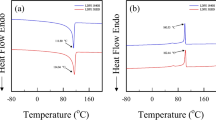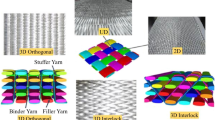Abstract
Modification using elastomeric thermoplastic polymers is commonly adopted to improve the high-temperature performance of paving bitumen. The performance of modified bitumen classified under the same grade is highly variable depending on the type of base bitumen, the polymer architecture, and its dosage. The current specification parameters are insensitive to such variability. Identification of a suitable set of parameters that can quantify the changes in rheological properties due to various interaction mechanisms of bitumen with modifier thus becomes necessary. In this study, the base bitumen obtained using two different processes, namely air rectification and component blending, are considered. Though the same grade of bitumen produced using both processes is considered, the material compositions are different, and this necessitated the use of different polymer architectures (diblock and triblock SBS) for the two binders. Three different dosages are used for each modifier. A stress relaxation experiment is conducted, and the peak modulus and stress relaxation time are determined. In addition, the continuous relaxation spectrum and the associated parameters are computed. The base bitumen and the polymer architecture of the corresponding polymer influenced the stress relaxation response substantially. These factors also influenced the response of the material captured using the relaxation spectrum and exhibited interesting insights regarding the influence of temperature.













Similar content being viewed by others
Data Availability
The datasets generated during and/or analyzed during the current study are available from the corresponding author on reasonable request.
Code Availability
The codes used in this study are available from the corresponding author on reasonable request.
References
Airey, G.D.: Styrene Butadiene Styrene polymer modification of road bitumens. J. Mater. Sci. 39(3), 951–959 (2004)
Airey, G.D., Brown, S.: Rheological performance of aged polymer-modified bitumens. J. Assoc. Asph. Paving Technol. 67, 66–87 (1998)
ASTM D2872-21: Standard test method for the effect of heat and air on a moving film of asphalt (rolling thin-film oven test). ASTM International, West Conshohocken (2021)
ASTM D7175-15: Standard test method for determining the rheological properties of asphalt binder using a dynamic shear rheometer. ASTM International, West Conshohocken (2015)
ASTM D7405-20: Standard test method for multiple stress creep and recovery (MSCR) of asphalt binder using a dynamic shear rheometer. ASTM International, West Conshohocken (2020)
ASTM D6373-21: Standard Specification for Performance-Graded Asphalt Binder. ASTM International, West Conshohocken (2021)
Bahia, U.H., Hanson, I.D., Zeng, M., Zhai, H., Khatri A, M., Anderson M, R.: Characterization of modified asphalt binders in Superpave mix design. NCHRP Report no. 459, (2001)
Baumgartel, M., Winter, H.H.: Determination of the discrete relaxation and retardation time spectra from dynamic mechanical data. Rheol. Acta 28, 119–144 (1989)
Becker, Y., Méndez, M.P., Rodríguez, Y.: Polymer-modified asphalt. Vis. Tecnol. 9, 39–50 (2001)
Bhattacharjee, S., Krishna, A., Daniel, J.S.: Continuous relaxation and retardation spectrum method for viscoelastic characterization of asphalt concrete. Mech. Time-Depend. Mater. 16, 287–305 (2011)
Bouldin, M.G., Collins, J.H., Berker, A.: Rheology and microstructure of polymer/asphalt blends. Rubber Chem. Technol. 64(4), 577–600 (1991)
Brule, B.: Polymer modified asphalt cements used in the road construction industry: basic principles. Transp. Res. Rec. 1535, 48–53 (1996)
Chakkoth, U., Krishna, K.R., Ramkumar, M., Hussain, S.A., Rao, P.V.C., Choudary, N.V., SriganeshG., Murali Krishnan, J.: Component blending for bitumen production for Indian refineries. Sadhana 45, 48 (2020)
Chen, J.S., Liao, M.C., Shiah, M.S.: Asphalt modified by Styrene-Butadiene-Styrene triblock copolymer: morphology and model. J. Mater. Civ. Eng. 14(3), 224–229 (2002)
Doi, M., Edwards, S.F.: The Theory of Polymer Dynamics. Clarendon Press, Oxford (1986)
Elseifi, M.A., Al-Qadi, I.L., Flinstch, G.W., Masson, J.: Viscoelastic modeling of straight and modified binders using the matching function approach. Int. J. Pavement Eng. 3(1), 53–61 (2002)
Gahvari, F.: Effects of thermoplastic block copolymers on the rheology of asphalt. J. Mater. Civ. Eng. 9(3), 111–116 (1997)
Glover, C.J., Davison, R.R., Domke, C.H., Ruan, Y., Juristyarini, P., Knorr, D.B.: Development of a new method for assessing asphalt binder performance durability, Texas Department of Transportation, Texas (2001)
Herrington, P.R., Patrick, J.E., Ball, G.F.A.: Oxidation of roading asphalts. Ind. Eng. Chem. Res. 33(11), 2801–2809 (1994)
Huang, J., Baird, D.G.: Ratio of dynamic moduli and estimation of relaxation times. J. Rheol. 46, 777 (2002)
IRC SP:53:2010: Guidelines on Use of Modified Bitumen in Road Construction. Indian Roads Congress, New Delhi (2010)
IS 15462:2019: Polymer Modified Bitumen (PMB) Specification. Bureau of Indian Standards, New Delhi (2019)
IS 73:2018: Indian Standard for Paving Bitumen - Fourth Revision. Bureau of Indian Standards, New Delhi (2018)
Keyf, S., Ismail, O., Corbacioglu, B.D., Ozen, H.: The modification of bitumen with synthetic reactive ethylene terpolymer and ethylene terpolymer. Pet. Sci. Technol. 25(5), 561–568 (2007)
Kluttz, R., Willis, J.R., Molenaar, A., Scarpas, T., Scholten, E.: Fatigue performance of highly modified asphalt mixtures in laboratory and field environment. In: 7th RILEM International Conference on Cracking in Pavements, pp. 687–696 (2012)
Kumar, Y., Singh, S.K., Oberoi, D., Kumar, P., Mohanty, P., Ravindranath, S.S.: Effect of molecular structure and concentration of styrene-butadiene polymer on upper service temperature rheological properties of modified binders. Constr. Build. Mater. 249, 118790 (2020)
Liu, H., Luo, R., Lv, H.: Establishing continuous relaxation spectrum based on complex modulus tests to construct relaxation modulus master curves in compliance with linear viscoelastic theory. Constr. Build. Mater. 165, 372–384 (2018)
Lu, X., Isacsson, U.: Rheological characterization of styrene-butadiene-styrene copolymer modified bitumens. Constr. Build. Mater. 11(1), 23–32 (1997)
Lu, X., Isacsson, U.: Chemical and rheological evaluation of ageing properties of SBS polymer modified bitumens. Fuel 77, 961–972 (1998)
Lu, X., Isacsson, U., Ekblad, J.: Rheological properties of SEBS, EVA and EBA polymer-modified bitumens. Mater. Struct. 32(2), 131–139 (1999)
Malkin, A.Y.: The use of a continuous relaxation spectrum for describing the viscoelastic properties of polymers. Struct. Prop. 48(1), 39–45 (2006)
Masson, J.F., Collins, P.G., Robertson, G., Woods, J.R., Margeson, J.: Thermodynamics, phase diagrams, and stability of bitumen-polymer blends. Energy Fuels 17, 714–724 (2003)
McKay, K.W., Gros, W.A., Diehl, C.F.: The Influence of Styrene–Butadiene diblock copolymer on Styrene–Butadiene–Styrene triblock copolymer viscoelastic properties and product performance. J. Appl. Polym. Sci. 56(8), 947–958 (1995)
Navarro, F.J., Partal, P., Martinez-Boza, F.J., Gallegos, C.: Influence of processing conditions on the rheological behavior of crumb tire rubber-modified bitumen. J. Appl. Polym. Sci. 104(3), 1683–1691 (2007)
Navarro, F.J., Partal, P., García-Morales, M., Martín-Alfonso, M.J., Martínez-Boza, F., Gallegos, C., Bordado, J.C.M., Diogo, A.C.: Bitumen modification with reactive and non-reactive (virgin and recycled) polymers: A comparative analysis. J. Ind. Eng. Chem. 15(4), 458–464 (2009)
Nivitha, M.R., Edamana Prasad, Murali Krishnan, J.: Ageing in modified bitumen using FTIR spectroscopy. Int. J. Pavement Eng. 17(7), 565–577 (2016)
Nivitha, M.R., Narayan, S.P.A., Murali Krishnan, J.: Non-linear viscoelastic model based ranking of modified binders for their rutting performance. Mater. Struct. 51(4), 1–14 (2018)
Nivitha, M.R., Roy, N., Murali Krishnan, J.: Influence of refinery processing methods on ageing of bitumen. Sadhana. Acad. Proc. Eng. Sci. 44(5), 1–8 (2019)
Petersen, J.C.: A review of the fundamentals of asphalt oxidation (E-C140). Transportation Research Record. J. Transp. Res. Board E–C140(October), 1–78 (2009)
Polacco, G., Stastna, J., Biondi, D., Zanzotto, L.: Relation between polymer architecture and nonlinear viscoelastic behavior of modified asphalts. Curr. Opin. Colloid Interface Sci. 11(4), 230–245 (2006)
Rajan, N.K., Selvavathi, V., Sairam, B., Murali Krishnan, J.: Influence of crude source on the viscous properties of blended asphalt. Int. J. Road Mater, Pavement Des. (2008)
Rakow, M.S.: Petroleum Oil Refining. In: Fuels and Lubricants Handbook: Technology, Properties, Performance, and Testing, pp. 3–30. ASTM International, West Conshohocken, PA (2003)
Riise, B.L., Fredrickson, G.H., Larson, R.G., Pearson, D.S.: Rheology and shear-induced alignment of lamellar diblock and triblock copolymers. Macromolecules 28(23), 7653–7659 (1995)
Rojas, J.M., Hernandez, N.A., Manero, O., Revilla, J.: Rheology and microstructure of functionalized polymer-modified asphalt. J. Appl. Polym. Sci. 115, 15–25 (2010)
Ruan, Y., Davison, R.R., Glover, C.J.: The effect of long-term oxidation on the rheological properties of polymer modified asphalts. Fuel 82(14), 1763–1773 (2003)
Sengoz, B., Topal, A., Isikyakar, G.: Morphology and image analysis of polymer modified bitumens. Constr. Build. Mater. 23(5), 1986–1992 (2009)
Stroup-Gardiner, M., Newcomb, D.E.: Polymer Literature Review. University of Minnesota, Report No. 95–27, 231 (1995)
Takeh, A., Shanbhag, S.: A computer program to extract the continuous and discrete relaxation spectra from dynamic viscoelastic measurements. Appl. Rheol. 23(2), 1–10 (2013)
Tayfur, S., Ozen, H., Aksoy, A.: Investigation of rutting performance of asphalt mixtures containing polymer modifiers. Constr. Build. Mater. 21(2), 328–337 (2007)
Tschoegl, N.W.: The Phenomenological Theory of Linear Viscoelastic Behavior: An Introduction. Springer, New York (1989)
Wineman, A.S., Rajagopal, K.R.: Mechanical Response of Polymers: An Introduction. Cambridge University Press, Cambridge (2000)
Winter, H.H.: The critical Gel. In: 99 NATO ASI Meeting, Les Houches, France, pp. 1–25. (2000)
Xu, O., Xiao, F., Han, S., Amirkhanian, S.N., Wang, Z.: High-temperature rheological properties of crumb rubber modified asphalt binders with various modifiers. Constr. Build. Mater. 112, 49–58 (2016)
Zhu, J., Birgisson, B., Kringos, N.: Polymer modification of bitumen: Advances and challenges. Eur. Polym. J. 54(1), 18–38 (2014)
Zorn, R.: Logarithmic moments of relaxation time distributions. J. Chem. Phys. 116(8), 3204–3209 (2002)
Funding
The authors thank the Science and Engineering Research Board (SERB), Department of Science and Technology, Govt. of India for funding the project under the Extra Mural Research Grant (now Core Research Grant) [No: EMR/2017/004702].
Author information
Authors and Affiliations
Contributions
All authors contributed to the study’s conception and design. Material preparation, data collection, and analysis were performed by Devika R., Nivitha M. R., and Neethu Roy. The first draft of the manuscript was written by Nivitha M. R. and all authors commented on previous versions of the manuscript. All authors read and approved the final manuscript.
Corresponding author
Ethics declarations
Conflicts of interest/Competing interests
The authors have no relevant financial or non-financial interests to disclose.
Ethics approval
Authors declare that the manuscript in part or in full has not been submitted or published anywhere.
Consent for publication
The authors hereby give the consent for the publication of identifiable details, the details within the text, figures, and tables in the manuscript submitted, to be published in the Mechanics of Time-Dependent Materials Journal.
Additional information
Publisher’s Note
Springer Nature remains neutral with regard to jurisdictional claims in published maps and institutional affiliations.
Rights and permissions
About this article
Cite this article
Nivitha, M.R., Devika, R., Murali Krishnan, J. et al. Influence of bitumen type and polymer dosage on the relaxation spectrum of styrene-butadiene-styrene (SBS)/styrene-butadiene (SB) modified bitumen. Mech Time-Depend Mater 27, 79–98 (2023). https://doi.org/10.1007/s11043-021-09531-y
Received:
Accepted:
Published:
Issue Date:
DOI: https://doi.org/10.1007/s11043-021-09531-y




